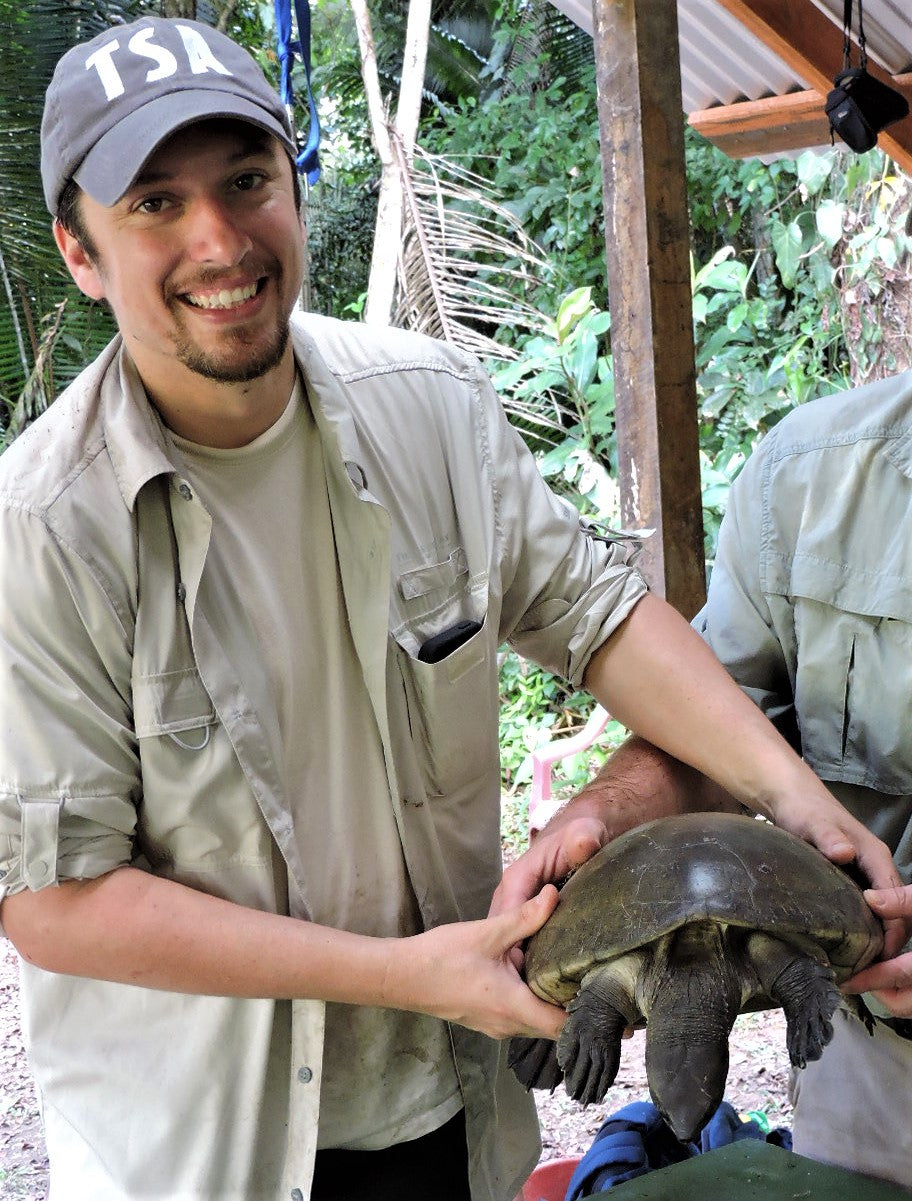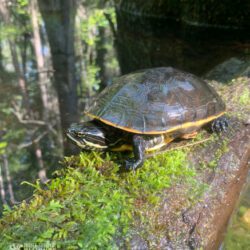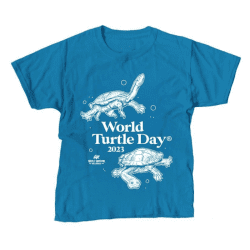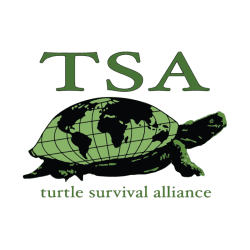Who: Shane Boylan, DVM
What: Chief Veterinarian, South Carolina Aquarium
Where: Charleston, South Carolina, USA
Jordan Gray: What is your earliest childhood memory with a turtle or tortoise?
Shane Boylan:¬†Like everyone, I’ve been watching/catching chelonia since I was little. When I was young, I toured North Carolina State University’s College of Veterinary Medicine. Although not my earliest memory, this is the most significant as it relates to my career. I always wanted to work with animals, but I never really considered veterinary medicine because of a bad experience my family had with my first dog. As a child, I took care of my pets, or of animals at the science center, but the greatest impression came from the injured cases where I¬†couldn’thelp. During the tour, veterinary students had a small table with an Eastern Box Turtle (Terrapene carolina carolina) named “Mr. T”. Mr. T had at least a dozen screws and cerclage wire holding his fractured carapace together, and it fascinated me. After seeing what could be done to save a hit-by-car box turtle, I was hooked.
JG: What is your favorite species of turtle or tortoise to work with?
SB:¬†The Eastern Box Turtle! I’ve grown up with them, and they are the best patients as a species. Most eat well in captivity and respond well to treatments. They don’t require six people to restrain and cost $10,000 in ozone, filtration, salt water, and pumps per turtle (Sea turtles, which are 70% of my patients can be a handful). Medically, Eastern Box Turtles are great patients for administering feeding tubes and for vacuum-assisted wound repair. The trauma these little guys can survive is just amazing! As they rehabilitate, we can house them outside, and we know their husbandry requirements. Add to the fact that a lot of them have major personalities and they can’t be beat!
JG: How did you first become involved in turtle and tortoise veterinary medicine and conservation?
SB:¬†I went to veterinary school to work on the “slimy and scaly,” which was my quote on Day 1 of class. NC State’s Turtle Team was the reason for my going to veterinary school; I really enjoyed the connection between people and local wildlife.
As it turns out, the big “2001 Hong Kong turtle confiscation” happened during my first year of veterinary school. I followed Drs. Greg Lewbart and Ryan DeVoe to Florida to aid the TSA with those confiscated animals. While assisting with the confiscation, the finding of drilled holes in the carapaces of the turtles, which keeps them tethered until they can be sold on the black market, made quite an impression. We took several dozen animals back to NC State that were in need of critical care. I tried to save a few dozen Southeast Asian Box Turtles (Cuora amboinensis) that were triaged as “not going to make it,” and we had a dozen Malaysian Giant Turtles (Orlitia borneensis) no other institution could manage.
Between the Turtle Team and TSA, I saw animals that could be treated successfully and had a real conservation goal. I like a challenge, and turtles are far better fighters than many mammals twice their size. Having a mentor like Dr. Lewbart who encourages his students to think independently and to save what others would consider a “lost cause” is crucial.
JG: What is the most amusing situation you have found yourself in, in a clinical environment?
SB: Rectally masturbating male Asian Elephants (Elephas maximus) for semen collection, and then performing artificial insemination in female Asian Elephants is certainly high on that list.
While in Florida attending to the 2001 confiscation, I was holding a turtle at eye level for an examination and calling out my findings when the turtle unloaded a huge defecation into my mouth. Nothing like feces from a sick, wild Asian turtle going directly into your mouth! It was amusing to everyone around me at least – I guess I was baptized into the TSA that day! I would say about half of the patients at the Turtle Survival Center (TSC) turn my shirt into a scatological Jackson Pollock painting during exams.
JG: Tell us about your most memorable travel experience that involved chelonians?
SB:¬†I’ve been fortunate to work with the TSA in Belize with the Central American River Turtle (Dermatemys mawaii) or “Hicatee” for several years now. I go to the Belize Foundation for Research and Environmental Education (BFREE) once to twice a year where they maintain a captive breeding colony for this species at the Hicatee Conservation and Research Center (HCRC). I perform health and reproduction exams in the field, and we troubleshoot filtration, nutrition, and water quality for the animals. The HCRC at BFREE is phenomenal; we learn something new about this species every time we work with them. It’s exactly the type of project where I feel I can be of benefit to conservation. Now, after years of losing pints of blood to flies while we workup Hicatees in the jungle, the BFREE staff feel like family; the people really make this project.
We dealt with a flood situation on one trip, which meant carrying our luggage for 6 miles (~10 km) in 10+ inches (25 cm) of mud. I had flu like symptoms hit me hard at mile 3 (km 5) of that hike. Call it Dengue, Zika, Chikungunya, or the nasty version of the ol’ flu, I’ve gotten the Belize bug several times now from the forest. If I shiver because it is cold in the winter, I thank my lucky stars I’m not shivering in 80 degrees F (27C) Belize with cold sweats from some virus. I think that qualifies as memorable! Ironically, on a trip catching American Crocodiles (Crocodyus acutus) in an open sewage lagoon in Ambergris Key, Belize, I was totally fine – go figure!
JG: Do you keep any turtles or tortoises at home? If so what species and how did you become involved with it?
SB:¬†I take in chelonia that have complicated health concerns (pathogens no one wants to treat) to avoid euthanasia. I learn how to treat turtles with bacterial, viral, or parasitic infections that are traditionally “collection killers”.
Brown Burmese Mountain Tortoise (Manouria emys): I found this animal at a reptile show mixed with Red-footed Tortoises (Chelonoidis carbonarius) as a vet student. “Gamora” as I named him, was blowing bubbles from his nose (potential mycoplasma infection), and his eyes were clouded over. I talked the vendor down in price so I could give treating him a shot. I’ve had Gamora now for over 15 years.
Indian Star Tortoises (Geochelone elegans): Mycoplasma positive animals no one wanted.
African Spurred Tortoises (Centrochelys sulcata): Sick pets that were surrendered to me for various health reasons. My larger female was given to me because she wasn’t eating well. She ended up passing a women’s hairband “scrunchy” after a few weeks of working on her.
Pancake Tortoises (Malacochersus tornieri): TINC (turtle intranuclear coccida) positive animals that needed a home. This pathogen has been a concern for TSA, and caring for animals daily with this disease really gives me insight into the husbandry and health aspects of caring for animals afflicted by it. I would like to see if I can get these tortoises to breed and produce TINC negative offspring.
Bourret’s Box Turtle (Cuora bouretti): TINC positive animals not wanted in most collections – so off to my house!
Side note: You never know when you’ll find a critically endangered Kemp’s Ridley Sea Turtle (Lepidochelys kempii) in my house recovering from a fishing hook removal surgery. Thankfully, those get back to the South Carolina Aquarium, and eventually the ocean.
JG: What attracted you to become part of the Turtle Survival Alliance?
SB: The TSA has both captive colonies and in situ programs for chelonian survival. I think a mulit-pronged approach is the best way to go about saving many species. Getting the local human population involved is crucial in the projects of Myanmar, Madagascar, India, and Belize, to name a few. Having assurance colonies here in the US also allows turtle biologists like us to understand husbandry and medicine while providing a golden parachute should species become extirpated in the wild.









